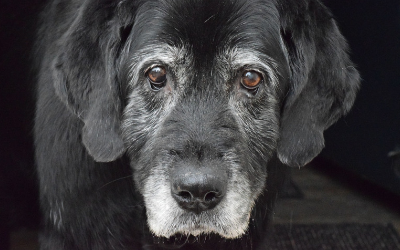
Studies have shown that pets are living longer these days, due to improved preventive care and nutrition, and advances in veterinary medicine. As our pets age, they experience many of the same health conditions and diseases that we experience as we age. Cancer is one of those diseases. Pet Cancer Awareness Month was established to educate pet owners on cancer prevention, the signs to look for, and the advancements in cancer treatments.
Pets can develop different types of cancer – just as we can. Cancer is quite common in dogs: 1 in 4 will develop cancer in their lifetime and almost half over the age of 10 will develop cancer. Certain breeds have a higher risk of developing cancer at a young age, but cancer is most often diagnosed in middle-aged and senior pets. There is less information on the rate of cancer in cats, but it seems that the incidence is about the same as in dogs, with 1 in 5 cats developing cancer in their lifetime.
While there are many different types of cancer that can affect our animal companions, some types occur more frequently than others. Some of the cancers diagnosed in pets are the same as those that occur in humans, including mammary gland (breast) cancer and lymphoma.
The most commonly diagnosed cancers in cats are:
- Lymphoma
- Fibrosarcoma
- Mast cell tumors
- Mammary gland tumors
- Feline leukemia-related cancers
- Various types of oral cancer
The most commonly diagnosed cancers in dogs are:
- Lymphoma
- Melanoma
- Mast cell tumors
- Osteosarcoma (bone cancer)
- Hemangiosarcoma (of the spleen)
- Various types of oral cancer
As with people, the cause of cancer in pets is largely unknown, making prevention difficult. However, we do know that certain cancers can be prevented. Taking the following steps can reduce the incidence of certain cancers:
- Spay your female pet. Spaying reduces the risk of mammary gland tumors in cats, dogs, and other pets, such as rabbits.
- Neuter your male pet. Neutering entirely eliminates the risk of testicular cancer.
- Keep your pet out of the sun, especially between the hours of 10am and 2pm. This reduces the risk of some forms of skin cancer.
- Vaccinate your cat for feline leukemia. This prevents feline leukemia virus infection which can cause several kinds of cancers.
- Avoid smoking in your home. This may prevent some forms of cancer, including oral cancers.
Early detection and treatment are the best ways to increase life expectancy if your pet does get cancer. The warning signs of cancer in pets are similar to those in people. Sometimes, however, the signs may not be obvious or specific, so any time your pet appears unwell or something doesn’t seem quite right, check with your veterinarian. Some warning signs to look for include:
- Lumps, bumps, or discolored skin
- Wounds that do not heal
- Enlarged lymph nodes
- Abdominal swelling
- Unexplained lameness
- Heat, pain or swelling
- Bleeding from the mouth, nose, or any other opening
- Difficulty breathing
- Difficulty eating
- Persistent diarrhea or vomiting
- Sudden weight changes
Many of the above signs can be seen with conditions unrelated to cancer, but they still need to be investigated by your veterinarian. If you observe any of the signs listed above, call your veterinary hospital to have your pet checked.
If your pet is diagnosed with cancer, there are many treatment options available, including surgery, cryosurgery, chemotherapy, radiation, and immunotherapy. Your veterinarian will discuss the best treatment options with you and help you choose a plan of care.
By taking your pet to your veterinarian for regular wellness checks and getting into the habit of checking your pet all over (looking for skin changes, lumps or bumps, and other signs) between wellness checks, earlier diagnoses can be made and more successful outcomes achieved.